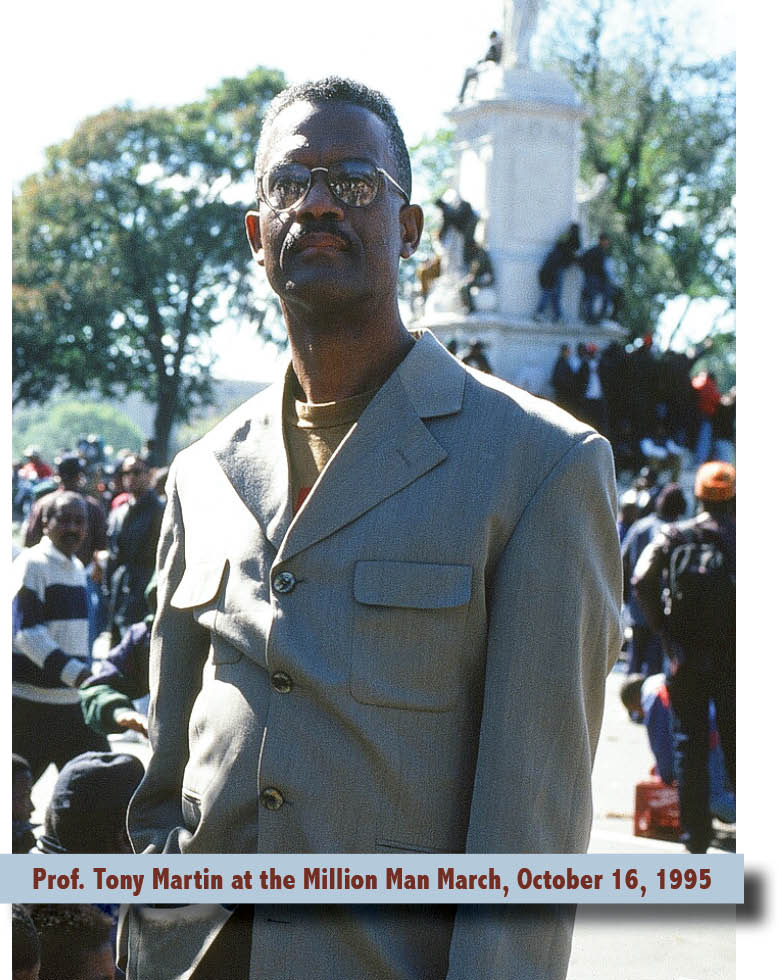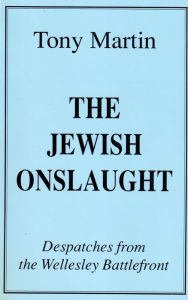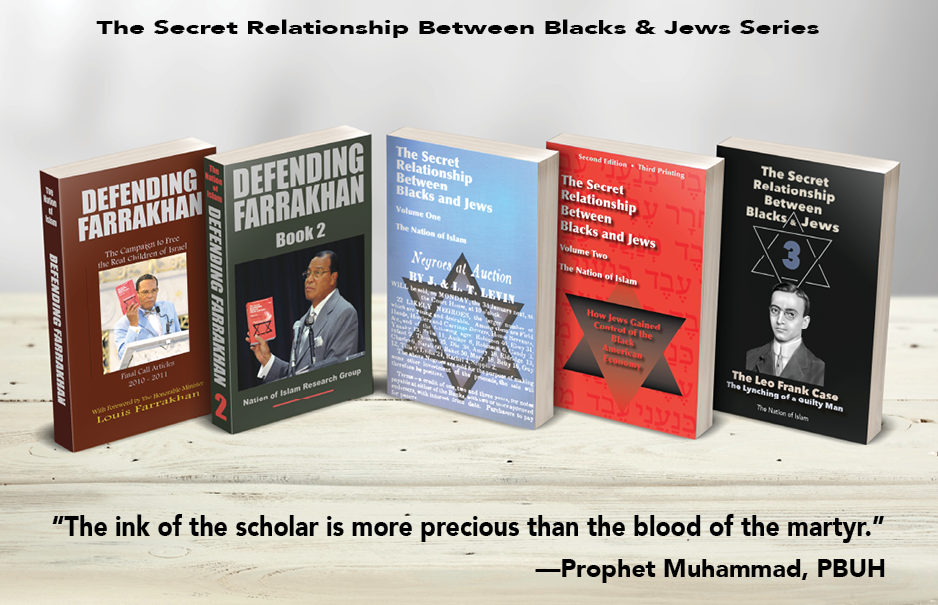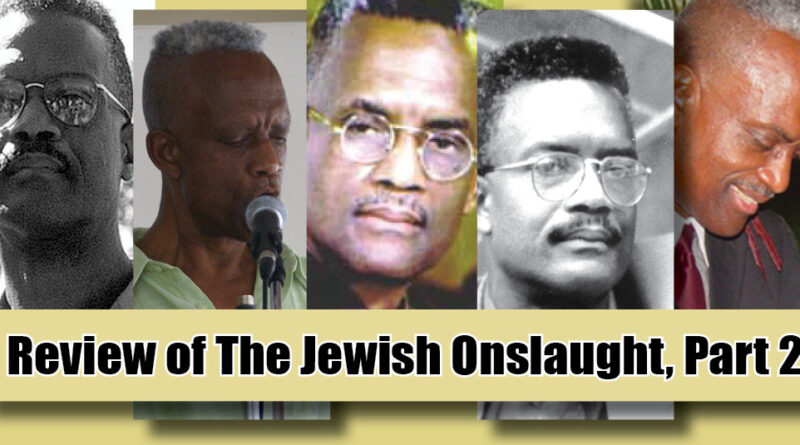Review of The Jewish Onslaught by Prof. Tony Martin, Part 2
Review of The Jewish Onslaught: Dispatches from the Wellesley Battlefront, Part 2
May 27, 2023 / by Bernard M. Smith
Martin’s story is simple enough—in 1993, he assigned The Secret Relationship Between Blacks and Jews as one of the texts to his class on American slavery. Someone noticed the book in the Wellesley College bookstore and took note. “Observers” were sent from the College Hillel (or Jewish college organization) to Martin’s class and an intervention by the College Hillel was ordered. Eventually, tremendous local and institutional pressure were brought to bear on Martin to recant his use of the book. He refused. The pressure then moved from within to without as the national media—including The New York Times, The Boston Globe, The Washington Post, and major television news program personalities such as David Brinkley and Ted Koppel—picked up the story to shower abuse and name-calling on Professor Martin. Other Black academics were enlisted (including Henry Louis Gates and a Black colleague from Wellesley) to excoriate Martin. Martin became synonymous with two things: he was an anti-Semite himself and his discipline, Africana Studies, was a worthless academic endeavor. He was likewise amazed at the refusal of the media—the same one tarnishing his name—to entertain fairness in allowing him to tell his side of the story. He was shellshocked by the patent double-standard. The same national papers that afforded his critics ample space to tear him apart refused to allow him to defend himself.

The Jewish Onslaught is three topics in one—first, it is a poignant account of what it means to go from relative anonymity to a national punching bag because one has the temerity to buck the Jews. He titled it correctly when he labeled it an “onslaught”. Tony Martin was a living, breathing human being who was destroyed for the relatively innocuous decision to assign a book to his undergraduate students and then refuse to buckle under when his masters demanded his recantation. The entirety of the book drips with the personal hurt that this human being endured at seeing his name and reputation sullied by very powerful forces. But again, this individual, for whatever reason, refused to “play ball” and apologize for his meager part in rehabilitating The Secret Relationship Between Blacks and Jews as a piece of scholarship.
Second, the book is a very concise look at the power dynamics of the people and organizations that were seeking to destroy him in real-time as a critique of Jewish power politics. In that sense, it reads like a book that is quite critical of outsized Jewish power. In short, I sense that if Tony Martin was an anti-Semite, the Jews have only themselves to blame for his views. I am certain that Martin never set out to tangle with the Jews—his academic interests were African-related, and his interest in the Jews was tertiary at best. Only after being set upon like a pack of wild dogs did he connect the dots of Jewish viciousness—and only thereafter did he attempt, in a modest way, to describe it. Third, it is a history of the attack itself—Martin reproduces the correspondence he received (both favorable and negative) as well as the various news accounts, contemporaneous writings, and reporting. In this, his training as a lawyer comes through (he was a U.K. barrister before becoming an academic).
The Jewish Onslaught is a book that Martin never intended to—and did not want to—write. He would have contented himself writing about his areas of academic interest for the rest of his quiet career but for an inconvenient student assignment and the backlash it generated. He, therefore, became an unlikely warrior in the exposition of Jewish power politics and control. But I am glad that he did. His essay on Jewish control, manipulation, and skullduggery reads with sincerity and authenticity partly because he was a reluctant expositor of the problem. As for the writing, he is a first-class writer and logician—and he comes back, incredulously at times, to the simple question that no one should be surprised that Jews took part in the African Atlantic slave trade so why am I being professionally and personally crucified for teaching it? His answer to that question opened his eyes to the reality that the relationship between the Jews and Blacks has never been one of reciprocity and respect—it has been qualified support for Blacks to do the things that the Jews want—and any deviation from that program requires a public and professional flogging.
What is more, once Martin dug a bit deeper into the Jewish-Black relationship, he discovered much more than merely the outsized Jewish role in African chattel slavery. He discovered that the Hamitic myth (that Africans are associated particularly with the Curse of Noah) was a creation of Talmudic sages more than a thousand years ago. He attributes that myth with softening the ground for later Christian views of African inferiority that itself was used in justifying the slave trade. And the Hamitic myth is overlaid by what he calls the myth of Jewish supremacy. His hate mail, mostly from Jews, demonstrated an almost unhinged and secret hatred by Jews for the “schvartze.” But be that as it may, hate mail comes from the most unhinged members of a community so there is no proof that it represented Jewish attitudes in general. That said, Martin, if he is to be believed, was surprised by the vitriol of anti-Blackness he received for his part in the affair.
* * *
There are six themes of The Jewish Onslaught that are worthy of highlighting. Again, I assume that if “they” had left Professor Anthony Martin alone, he never would have been inclined to research and make these claims. First, he observes that “the very least that can be said in the present case is that Jewish ability to influence the major media is very impressive indeed.” Martin witnessed it first-hand, and, because of it, he researched that which should be known to those who have undertaken only a cursory glance at who runs the media in this country. Yes, the Jews have an overwhelming stranglehold over the information in the United States, and this control necessarily has implications on what constitutes “news” and what does not. That, for example, the American public is barraged with information regarding the Iranian nuclear program while not one American presidential candidate has ever been asked their opinion of Israel’s clandestine nuclear program—even though Israel, as the pariah nation that it is, is a recalcitrant non-signatory to the Nuclear Non-Proliferation Treaty. Or more to the point, why are the American people continuously fed the lie that Israel is our “greatest ally.” Who says? Especially as it pertains to Israel, the American media carries water like a lackey for Israeli misdeeds. But for the Jewish stranglehold on media and information, the American public would undoubtedly have a very different take on our “greatest ally.” Martin simply caught a glimpse of the power of the Jewish media machine to grind down the opposition—even if the opposition itself is of little value or importance. Martin never connected that control to other Jewish initiatives and agendas but the mere fact that he observed it—in a chapter entitled “Major Media”—is enough.
Second, Martin makes the more pained point that some of his Black brethren fomented the attack on him. He uses that reality as a springboard for describing how Jews have co-opted and infiltrated Black leadership and organization for their ends. He recounts how the Jews have insisted, for example, that Louis Farrakhan be excluded from major Black summits or events, or their support (and money) would be withdrawn. As it relates to Farrakhan and his views, the question isn’t whether we agree with him (and, more to the point, as Whites, what business is it of ours to tell the Black community who can or cannot have a voice within their community), the point rather is that Farrakhan is no more beyond the pale in terms of other Black voices save for his lifelong critique of Jewish involvement in what he considers to be “intra-Black” debates. For that reason, and not his vitriol generally, Farrakhan must not only be purged from general American audiences, but he must also, if possible, be purged from Black audiences as well.
The gist of Martin’s critique is that the Jews, wholly supportive of the integrationist wing of Black America, do everything that they can to squelch the normalization and voice of Black separatists. Martin sees, correctly I might add, that Jews have a thumb on the scale of what should be an intra-Black dispute about leadership and direction. Integration serves the needs of the Jews—it makes Blacks vote in a way that mirrors the Jews and in support of politicians chosen by the Jews. It is no small thing that control over Black leadership is of enormous consequence to the Jews—they multiply their power electorally in the United States by adding ten percent of the population to their side. Black intellectuals that would question that relationship—or the Jews generally—must be crushed. Sometimes, one cannot resist the query: who do these people think that they are to manipulate anyone and everything?
Third, Martin offers a chapter entitled “Jewish Racism.” In it, he connects the dots that Jews are generally racist towards Blacks—questioning their abilities and their African Studies Departments. Martin observed first-hand, in the mail he received and the professional criticism he endured, that Jewish toleration of him (as a Black professional) and his discipline (African Studies) was contingent on his ability to leave well enough alone. He was on the receiving end of critics who called him a fraud—that his teaching was a fraud—and probably an affirmative action fraud as well. In addition to the Hamitic myth, discussed above, Martin appeared generally shocked by the bilious language used by his detractors to describe him and the debate.
Fourth, Martin makes an interesting point about the logic of “some Jews.” When Jews are forced to admit some collective failing, they insist that blame cannot be assigned to “the Jews,” but only that “some Jews” did this or that. He also writes how this “some Jews” mantra is shared by, ironically enough, all Jews. He observes:
The campus ultra-Zionist who is usually in a state of war with the campus Jewish power elite, the power elite themselves, the liberals (like the one who for years had regaled me with stories of her civil rights involvement), the former infantile left-wing communist now turned pseudo-liberal Jewish nationalist—all spoke as with one voice on this issue. “It’s a lie,” they sang in choral unison. “Jews were not an important part of the slave trade. ‘Some Jews,’ maybe, but that’s all. The book is anti-Semitic, and you are hateful for using it.”
To which he replies, cleverly enough, “and I am yet to meet the Jewish historian who will tell you that ‘some Englishmen’ established an empire on which the sun never set.” What the Jews have established, at least in terms of acceptable historiography of the Jews themselves, is that when we speak of laudable characteristics, we may speak of “the Jews”; yet when we speak of not-so-laudable characteristics or activities that are deplorable, we must speak only of “some Jews.” Only the good sticks to all, the bad is relegated to a few bad apples. Ask yourself a question, what other people demands such historiography? Martin’s insight here is alone worth the price of admission.
In a chapter entitled “Black Solidarity,” Martin recounts the overwhelming support he received from the Black community minus a few public Black detractors. But what Martin spends his time deconstructing is the infiltration of Black (and other ethnic groups) by Jewish organizations. He recounts information that was not familiar to me—the Anti-Defamation League ran illegal spying operations across the country in the 1990s—some “12,000 or more individuals and 950 organizations were said to have been the objects of the ADL’s unwelcome attention.” This was a matter of public record and reported, if briefly, in the mainstream news. From this, Martin observes that “ethnic associations” seem to fascinate the ADL, and the ADL sidestepped the controversy of its spying by sanctimoniously claiming it had an obligation to “expose extremist, racist and anti-Semitic organizations and groups.” Martin was therefore lumped into the same category as the Klan for purposes of the ADL’s watchful eye. To which Martin replies, “who will spy on the real bigots while they spy on the alleged bigots?”
The last theme that Martin touches upon is “Afrocentrism,” which he defines as, “assert[ing] that African people must interpret their own reality and see the world from their own perspective. [It] rejects both the claims of the racist and the efforts of friendly but paternalistic representatives of other races to speak for the African.” Again, this language hearkens back to the discussion above about the Black separatist wing of thought that, even if it does not call for political separation, casts a wary eye towards the liberal non-Blacks lining up to “do good” for the Black community. Martin believes that “Afrocentrism,” so defined, is considered by Jews to be their natural enemy. He views this to be so because Jews are now well-ensconced in the upper echelons of White society and wish to protect their privileged position. In this, he notes that the Jews have become “White,” and now serve to protect “Whiteness.” One area of this debate, which is something I knew only a little about, is the question of Greece, Egypt, and the role of Africa. He says that Jews are the academic leaders of the “whitenizing” or “de-Africanizing” of Egypt. He sees that the Jews have been vocal advocates for the ideas that ancient Egyptians—the civilization-builders anyway—were not “Africans” but dark-skinned Greeks or hybrid Greeks. He makes the further point that the Greeks were much closer in culture and geography to the Ethiopians than they were to the peoples of Northern Europe who now claim the ancient Greeks as their own. He offers, in a few pages, why he believes that Greece is indebted to Egypt for its culture, and why Egypt, in turn, must be considered an African power.
This is an interesting side question—it is undoubtedly true that Northern and Western Europeans see themselves in continuity with the Hellenistic world—and that Western Civilization, with ancient Greece being its anchor, is unique. Homer, Plato, Socrates, and Aristotle are “our” people, and their ideas on philosophy, governance and ethics are “our” collective civilizational idea.
Indeed, we see those Greeks as “White” and one needs only a cursory review of ancient Greek art and statuary shows to realize that while Ethiopia may be closer to Helles than Norway, the people of Greece were more racially similar to the people of Norway than they were the people of Ethiopia. For my part, I do take ownership of a meta-culture and people best embodied by “Western Civilization” that includes the Greeks and that is, racially anyway, White. Martin would like to do one of two things: cut ancient Greece down to size as something like a cultural interloper concerning Africa; or cut loose ancient Greece from Europe and “Western Civilization” and reorient it into a North African orbit. From what I have read of ancient Greece and the Hellenistic world, it formed a semi-circumference around the Eastern Mediterranean Sea and stretched from Sparta along the coast to Alexandria and even more Western points. Ethiopia, while not directly a part of the Hellenistic world (not unlike Persia), was an impressive culture and civilization, which cannot be denied; but it was not a progenitor of the West.
It seems to me that the reason that Martin and his fellow Afro-centrists are so desperate to untether or delegitimize ancient Greece and tie it, in one way or another, to “Africa” is because the reality of sub-Saharan Africa has been so abysmal and backward. He is right on one point—as a crow flies, the ancient Greeks that I count as “fathers” were further from my people on the West Coast of Ireland than they were from the dark-skinned Ethiopians. But geography and cartography are what they are: Greece is in Europe, so defined, and the peoples of Europe claim her as their own and recent genetic evidence confirms the relationship of Europe with ancient Greece. The reality is that in language, culture, mannerisms, and opinions, Northern and Western Europeans (whether we lived in caves during Homer’s time or not) are the chief inheritors and children of ancient Greece.
* * *
To prove that a controversy involving Professor Martin, now dead for ten years, is far from history—consider the following that involves the Biden Administration’s nomination of one Krist[e]n Clark[e]:
Kristen Clarke, President-elect Joe Biden’s nominee to head the civil rights division at the Justice Department, said it was a mistake to have invited the author of an anti-Semitic screed to speak at Harvard when she headed a black student group there. In 1994, Clarke as the leader of a Black Student Association invited Tony Martin, author of a book called “The Jewish Onslaught,” to speak and defended him afterward. Jews on campus at the time were appalled by the invitation.
“Giving someone like him a platform, it’s not something I would do again,” she told the Forward on Thursday. Clarke, the president of the Lawyers’ Committee for Civil Rights Under Law, has worked closely in recent years with Jewish groups in combatting white supremacists. Biden announced his choice of Clarke on Monday, which earned praise from the Anti-Defamation League. The following day Tucker Carlson, a Fox News Channel host, uncovered 1994 stories in the Harvard Crimson about the Martin controversy. Subsequently, statements from liberal Jewish groups backing Clarke were more pointed in rejecting the bid to stigmatize her with actions she took as a student.
“This week, Kristen Clarke acknowledged she made a mistake when, as a student at Harvard, she gave a professor who promoted antisemitic conspiracy theories a platform,” Bend the Arc: Jewish Action said Thursday on Twitter. “She unequivocally denounces anti-Semitism — and acts upon that commitment in fighting religious discrimination.” Also praising Clarke on Thursday for her work combatting anti-Semitism were the National Council of Jewish Women, the Jewish Democratic Council of America, and Joel Rubin, the American Jewish Congress executive director.
Rabbi Jill Jacobs, who directs T’ruah, a rabbinical human rights group, said in an interview that Clarke’s statement this week was a “model of teshuvah,” or repentance, and derided those on the right who would stigmatize someone for something they said as a teenager. Some of Carlson’s attacks on Clarke include remarks by Clarke, ripped from context, about white supremacy during her Harvard years, when she contrasted it with black supremacy. “It’s not accidental that people on the right are specifically going after women of color and trying to dig up anything from their past even if it’s something that happened when they’re 19,” Jacobs said.
How pathetic indeed is the need for teshnuvah from these people? I suppose that selling Professor Anthony Martin out posthumously—and sacrificing her convictions—was a small price to pay for Ms. Clarke’s sinecure at the Justice Department.
Well, at least the Jews are happy. Aggressive, manic, paranoid, and neurotic; but happy.
* * *
Saint Paul, Pray for Us.
[Originally posted here: https://www.theoccidentalobserver.net/2023/05/26/review-of-the-jewish-onslaught-dispatches-from-the-wellesley-part-1/]

Purchase Prof. Tony Martin’s The Jewish Onslaught here:

Purchase The Secret Relationship Between Blacks & Jews series here
Listen to The Honorable Minister Louis Farrakhan share how he was subtly threatened by Jewish leaders in Chicago if he did not denounce
The Secret Relationship Between Blacks & Jews:
https://www.bitchute.com/embed/SfceA7cSMHfy/
In this video Professor Tony Martin exposes the origins of slavery, the Hamitic Myth that Jews have used to justify the enslavement of Black people:

